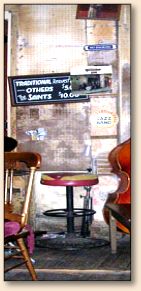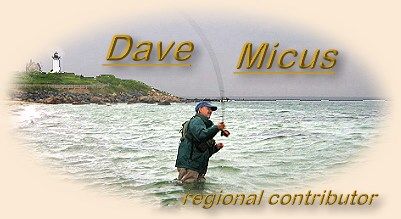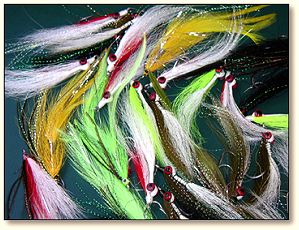|
It began, as so many of my fly fishing adventures and
misadventures do, with a phone call from my good friend,
Dick Brisbois, who lives in the White Mountains of New
Hampshire.
"There's a new fly shop opening in town," Dick told me in
the lowered voice that fly fishers affect on the phone in
case it is tapped by someone trying to find their secret
fishing holes. "I struck up a conversation with the owner
and he mentioned he needs a salt water fly tyer. I told him
about you and he'd love to see some of your flies."
Though right now I have a lot on my plate-a full time job,
a part time job, and fishing every chance I get because it
is striper season-the idea intrigued me. Inflated my ego
probably says it better. When you start thinking of fly
fishing more as an avocation than a hobby, it is only natural
to try and figure out ways to make money at it. This could be
my chance. "He'd like you to tie up a dozen deceivers and
clousers," Dick continued and my interest waned.
 There is a sign on the wall of the venerable Preservation
Hall in New Orleans that reads:
There is a sign on the wall of the venerable Preservation
Hall in New Orleans that reads:
Traditional Request: $ 2.00
Others: $ 5.00
"The Saints": $10.00
and this about sums up how I feel toward clousers and deceivers.
Are they great salt water flies? Definitely. Productive? Most
assuredly. But unfortunately their popularity has lowered
them to the status of cliché, and no doubt a fly fishing
expedition mounted by the National Geographic Society for the
heretofore believed extinct coelacanth off the coast of Africa
would list among their inventory of necessary supplies "six
dozen white deceivers and chartreuse clousers." Just as serious
jazz musicians prefer not to play The Saints for tourists, I
prefer not to tie clousers and deceivers.
A second concern was his request for two dozen flies with
no mention of money. Expecting me to fork over $100 worth
of flies on the cuff seemed presumptuous to say the least.
Instead I sent him two clousers, two deceivers, and two
flies of my own design (called either "the Micus Minnow"
or "Dave's Deceiver"-the lawyers are still hashing it out).
I heard from Dick a few days latter telling me the
owner loved the flies and wanted me to contact him. I
sent him an email, and received a response that was a
bit disconcerting. He liked all the flies, especially
the Micus Minnow (or Dave's Deceiver-still haven't heard
from the lawyers), but wanted it weighted. This was like
asking for clousers unweighted-it was not the intent of
the design. And he again failed to mention financial
remuneration.
I've come to realize there are some jobs so good that
your employer expects you to almost work for free, and fly
fishing seems to have more than its fair share of these
positions. In the past year I've published nearly 50
articles on fly fishing, many with photos, including
articles in regional and national magazines. My total
pay has been $350, hardly enough for my fishing camp in
Patagonia. But the writing really isn't work, more like
a compulsion, so any reward, even a simple compliment
(hint hint), suffices.
Fly tying is a different story, though.
While I enjoy tying flies I have never been a production
tyer. I fish the salt, usually with large baitfish
patterns, and it is rare to lose a fly-occasionally a
blue fish will chomp one off, but for the most part I
only replace flies when the ones I'm using get too ragged.
Now I would have to sit down and do some serious time at
the vise, and before doing so I wanted a firm financial
commitment. I wrote again, a one liner that simply asked,
"What's the pay?" and received the answer: "I pay $1 per
fly for salt water flies." Now I know that salt water flies
sell for between $4 and $5, and I would be supplying the
material as well as paying for shipping, so I was positive
that his response contained a typo. "I couldn't tie salt
water flies for $1 a fly," I wrote back, expecting him to
respond, "$1???!!! I hit the wrong key!!! Hahaha. It
should be $3!" Once again I was being naive. "$1 is all
I pay. I get all of my salt water flies for $1 and my
freshwater flies for fifty cents."
Ohhhh…..
"They must be tied in Africa," I blurted out, and this,
inexplicably, touched a nerve. "I'm a serious fly shop,
not one of those junk shops, and I don't sell inferior
products. My flies are tied in Tie-land," he responded
curtly, insinuating that sweatshops in Tie-land are somehow
better than sweatshops in Africa.

"I still can't do it for the price," I answered. "Just
keep the flies," I added magnanimously, grateful that I
didn't send two dozen and happy to end this relationship.
But like many a fly shop owner, he felt compelled to
deliver The Lecture. "I buy a lot of flies for the prices
I told you," he wrote. "I don't get any complaints. A
lot of my tiers make a good living," which is probably true,
but the cost of a good living in Tie-land is likely a
helluvalot less than here in the U.S. of A. "You could
tie flies faster. Get a fly drying wheel for those epoxy
flies," then felt it necessary to add, "I've been fly fishing
a long time" insinuating that I haven't.
Now this shop is inland, and I would readily wager that
I have caught more striped bass this season than my
potential employer has in his entire life. And I wasn't
haggling about the price, or looking for a lecture, just
turning down an incredibly low paying job. While I
admired his business savvy-attempting to make 400%
profit on the fruits of my labors-his recruitment
methods left something to be desired. I let it drop.
But I know now that if I ever do get into commercial
tying, I'll start my own on-line store and reap 100%
of the profits for my work. I even have the pricing
structure figured out:

~ Dave
About Dave:
 Dave Micus lives in Ipswich, Massachusetts. He is an
avid striped bass fly fisherman, writer and instructor.
He writes a fly fishing column for the Port City Planet
newspaper of Newburyport, MA (home of Plum Island and Joppa Flats)
and teaches a fly fishing course at Boston University.
Dave Micus lives in Ipswich, Massachusetts. He is an
avid striped bass fly fisherman, writer and instructor.
He writes a fly fishing column for the Port City Planet
newspaper of Newburyport, MA (home of Plum Island and Joppa Flats)
and teaches a fly fishing course at Boston University.
|





 There is a sign on the wall of the venerable Preservation
Hall in New Orleans that reads:
There is a sign on the wall of the venerable Preservation
Hall in New Orleans that reads: Dave Micus lives in Ipswich, Massachusetts. He is an
avid striped bass fly fisherman, writer and instructor.
He writes a fly fishing column for the Port City Planet
newspaper of Newburyport, MA (home of Plum Island and Joppa Flats)
and teaches a fly fishing course at Boston University.
Dave Micus lives in Ipswich, Massachusetts. He is an
avid striped bass fly fisherman, writer and instructor.
He writes a fly fishing column for the Port City Planet
newspaper of Newburyport, MA (home of Plum Island and Joppa Flats)
and teaches a fly fishing course at Boston University.